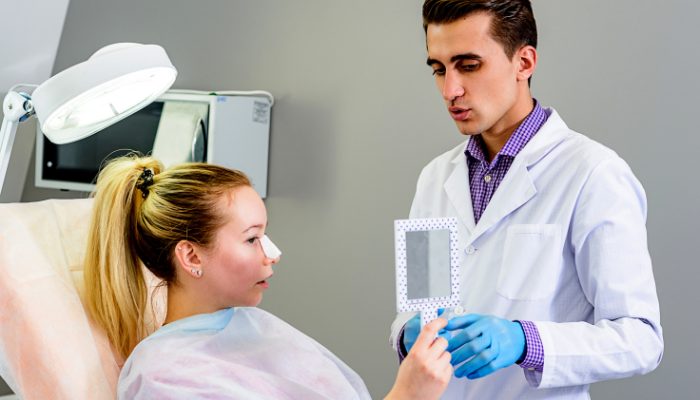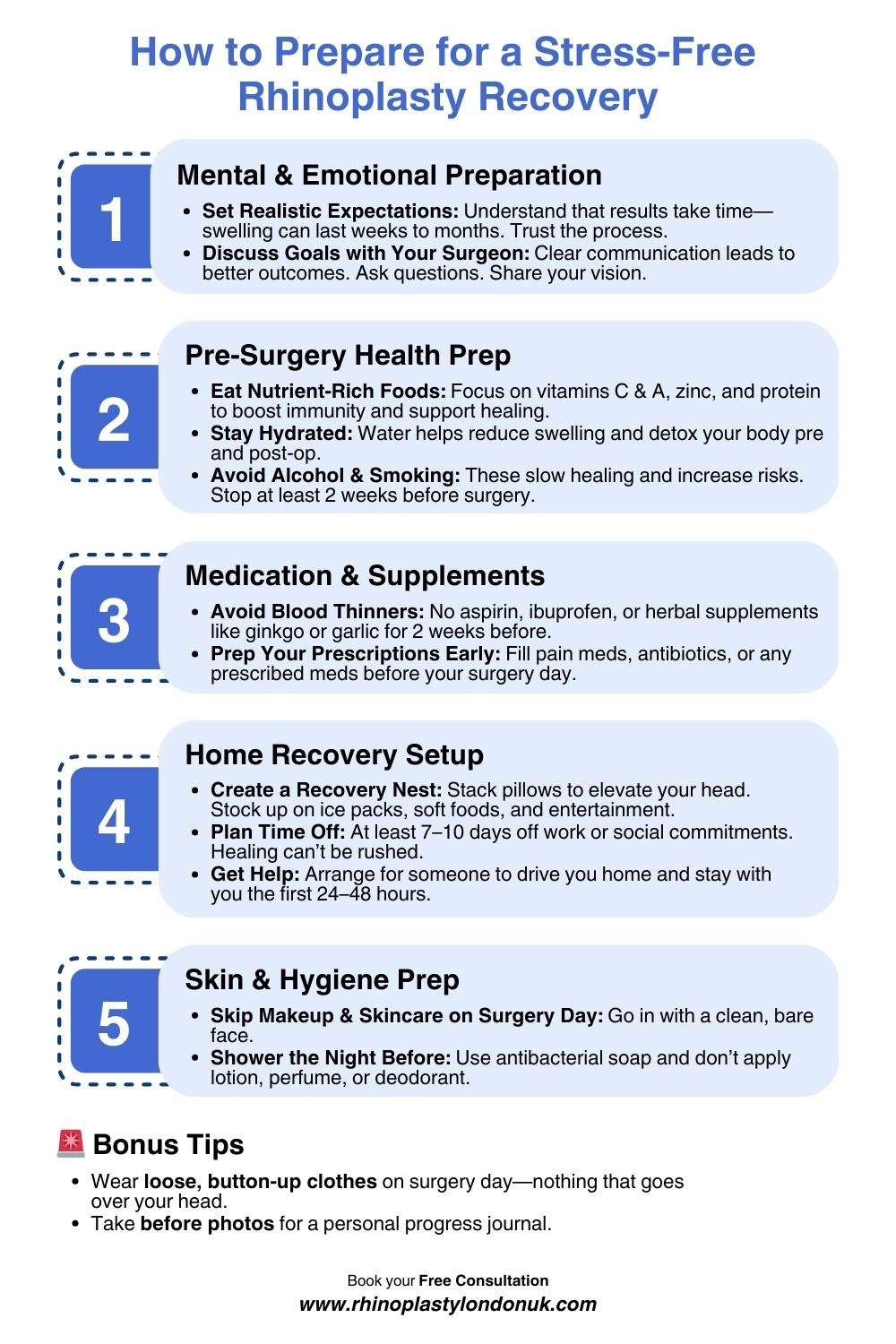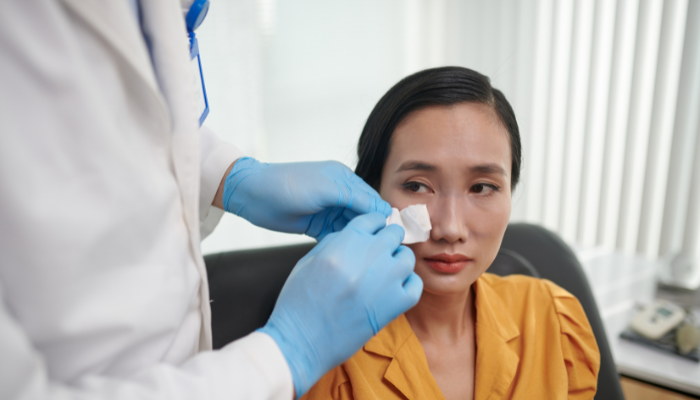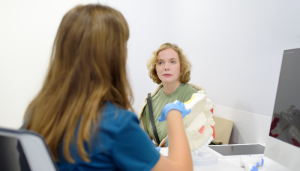So, you’re getting a nose job—or maybe you’ve just had one. Either way, congrats! You’re one step closer to the look you’ve been envisioning. But now comes the big question: What happens next?
Rhinoplasty recovery isn’t exactly a one-size-fits-all experience, and let’s be honest—no one wants to spend their downtime guessing what’s normal and what’s not. That’s why we’ve created a clear, week-by-week guide to help you know what to expect, from swelling and bruises to the moment your new nose finally settles in.
This isn’t sugar-coated or overly clinical—it’s the real, balanced info you need. Whether you’re planning ahead or currently mid-recovery and wondering if you’ll ever breathe normally again (you will!), we’ve got your back.
Let’s dive into what recovery really looks like—one week at a time.
Key Takeaways
- Recovery from rhinoplasty takes several weeks, with noticeable changes each week.
- Managing swelling and bruising is crucial in the first week; rest and elevation are key.
- The splint is usually removed in the second week, allowing for a return to light activities.
- By weeks three to four, most swelling decreases, and you can reintroduce moderate exercise.
- Final results may take up to a year to fully manifest, with ongoing changes in appearance.
Understanding Rhinoplasty Recovery Time

It’s a good idea to know what to expect during the recovery because everyone’s race is a little different. Understanding the recovery timeline can really help you prepare and make the whole process smoother.
Initial Healing Phases
Right after the surgery, your body kicks into healing mode. Expect some swelling, bruising, and maybe a bit of discomfort. This is all part of the process as your body repairs the tissues and settles into the new shape.
The first week or two are usually the most intense, but things start to improve pretty quickly after that. It’s like when you’ve had a tough workout – you feel it at first, but then you start to recover and feel stronger.
Factors Influencing Recovery
Loads of things can affect how quickly you heal. The type of rhinoplasty you had, your overall health, and even your age can play a role. Some people naturally heal faster than others.
And, of course, how well you follow your surgeon’s instructions makes a big difference.
Importance of Aftercare
Speaking of following instructions, aftercare is super important. This means resting, keeping your head elevated, taking any prescribed medications, and attending your follow-up appointments. Skipping aftercare steps can slow down healing and increase the risk of complications, so it’s worth taking the time to do it right.
Proper aftercare is not just a suggestion; it’s a necessity for achieving the best possible results from your rhinoplasty. It’s about giving your body the support it needs to heal effectively and ensuring a smooth transition to your new look.
Week One: Immediate Post-Operative Care
Week one is all about immediate aftercare. It might feel a bit intense, but stick with it, it gets better. This initial period is crucial for setting the stage for a smooth recovery.
Managing Swelling and Bruising
Okay, let’s be real, you’re going to have some swelling and bruising. It’s just part of the process. Expect it around your eyes, nose, and cheeks. It usually peaks around day three, so don’t freak out if it looks worse before it looks better.
Here’s what you can do:
- Cold Compresses: Apply them gently (not directly on your nose) for about 15-20 minutes at a time, several times a day. This helps reduce swelling and ease any discomfort.
- Keep Your Head Elevated: Especially when you’re sleeping. Prop yourself up with a few pillows. Gravity is your friend here, helping to drain fluids away from your face.
Rest and Elevation
Rest. I know it’s tempting to get back to normal life, but your body needs time to heal. Think of it as a good excuse to binge-watch that show you’ve been meaning to see.
- Avoid Strenuous Activities: No gym, no heavy lifting, no running a marathon. Keep it chill.
- Get Plenty of Sleep: Aim for at least 8 hours a night. Sleep is when your body does most of its repair work.
- Delegate Tasks: Get someone else to do the chores, look after the kids, walk the dog. You need to focus on you.
It’s really important to avoid blowing your nose during this first week. It can put pressure on the healing tissues and potentially cause problems. If you need to clear your nose, gently dab it with a tissue.
Follow-Up Appointments
You’ll likely have a follow-up appointment with your surgeon within the first week. This is a chance for them to check how you’re healing, answer any questions you have, and generally make sure everything’s on track.
- Write Down Your Questions: Before the appointment, jot down anything you want to ask. It’s easy to forget things when you’re feeling a bit overwhelmed.
- Be Honest About Your Symptoms: Don’t be afraid to tell your surgeon if you’re in pain, feeling anxious, or noticing anything unusual. They’re there to help.
- Follow Their Instructions: Your surgeon will give you specific instructions for aftercare. Stick to them religiously. They know what they’re doing!
Week Two: Adjusting to Changes
Week two marks a significant step in your rhinoplasty recovery. You’re moving past the initial post-operative phase and starting to see some real changes. It’s a time of adjustment, both physically and emotionally, as you begin to resume some of your normal activities and get a glimpse of your new nose.
Removal of Splint and Bandages
One of the most anticipated moments of week two is the removal of the splint and bandages. This usually happens around day 7, during a follow-up appointment with your surgeon. While it’s exciting, remember that your nose will still be swollen and may not look exactly as you expect. Don’t be alarmed if you see some bruising as well; this is perfectly normal. The initial reveal is just the beginning of the healing process.
Resuming Light Activities
By week two, you can typically start reintroducing light activities into your routine. This doesn’t mean hitting the gym for a heavy workout, but gentle walks and household chores are usually fine.
Avoid any strenuous activities that could raise your blood pressure or risk trauma to your nose. Listen to your body and don’t push yourself too hard. If you experience any pain or discomfort, take it easy.
Monitoring for Complications
While complications are rare, it’s important to keep an eye out for any signs of infection or other issues. These could include:
- Increased pain or swelling
- Redness or warmth around the incision sites
- Fever
- Unusual discharge
If you notice any of these symptoms, contact your surgeon immediately. Early intervention can help prevent more serious problems and ensure a smooth recovery. It’s always better to be cautious and seek professional advice if you have any concerns.
Weeks Three to Four: Gradual Improvement
Alright, you’re past the initial hurdles! Weeks three and four post-rhinoplasty are generally about seeing more noticeable improvements. It’s like the fog is starting to lift, and things are becoming clearer, both literally and figuratively.
You’ll likely feel more like yourself again, which is a massive win.
Decreasing Swelling
Swelling continues to decrease, although it might still be noticeable, especially in the tip of your nose. Don’t stress too much; this is normal. Be patient, and remember that final results take time.
You might find that the swelling fluctuates a bit – it could be worse in the mornings or after certain activities. Gentle massage, as advised by your surgeon, can sometimes help.
Reintroducing Exercise
Thinking about getting back to the gym? Good news! You can usually start reintroducing light exercise around this time. Think gentle walking, maybe some light cycling. Avoid anything too strenuous that could increase blood pressure in your face.
Listen to your body; if something feels uncomfortable, stop. It’s better to take it slow and steady than to risk setbacks.
Emotional and Physical Adjustments
By now, you’re probably getting used to your new appearance, even though it’s not quite the final result. It’s normal to have some emotional ups and downs during this period.
You might feel excited one day and a bit self-conscious the next. Remember that this is a process, and it’s okay to have these feelings. Talk to friends, family, or even a therapist if you’re struggling. Physically, you should be feeling more comfortable, with less pain and discomfort. Keep following your surgeon’s aftercare instructions, and you’ll be well on your way to a full recovery.
It’s important to remember that everyone heals at their own pace. Don’t compare your recovery to others. Focus on following your surgeon’s advice and taking care of yourself. If you have any concerns, don’t hesitate to reach out to your surgical team. They are there to support you throughout the entire process.

Weeks Five to Six: Nearing Normalcy
Alright, you’re getting there! Weeks five and six post-rhinoplasty often bring a sense of things returning to normal. You’re likely feeling more like yourself again, and the most obvious signs of surgery are starting to fade.
It’s a good time to start feeling positive about the changes, even though the final result is still a ways off.
Continued Healing Process
Swelling should continue to decrease noticeably during this period. Around 50% or more of the initial swelling should be gone by now, but remember that everyone heals at their own pace.
You might still experience some subtle swelling, particularly in the tip of your nose. Don’t stress too much about it; this is perfectly normal. Internally, the tissues are still healing and settling into their new position.
Assessing Results with Your Surgeon
This is usually when you’ll have another follow-up appointment with your surgeon. They’ll assess how you’re healing and address any concerns you might have. It’s a good opportunity to discuss your progress and ask any questions that have popped up.
They can also give you a better idea of what to expect in the coming months.
Lifestyle Adjustments
By now, you can probably resume most of your normal activities, but still take it easy. Avoid any strenuous exercise or activities that could put your nose at risk of injury.
If you wear glasses, make sure they’re not putting too much pressure on your nose. You can also start thinking about any long-term lifestyle adjustments that might be necessary to maintain the results of your surgery.
It’s important to remember that healing is a marathon, not a sprint. Be patient with yourself and your body, and don’t get discouraged if you don’t see the final results immediately. Keep following your surgeon’s instructions, and you’ll get there in the end.
Months Six to Twelve: Final Results
Months six to twelve post-rhinoplasty are all about seeing those subtle, yet significant, changes that really define your new nose. It’s a waiting game, but a rewarding one.
Long-Term Changes in Appearance
This is where you’ll really start to appreciate the final shape and contour of your nose. The remaining swelling is gradually resolving, revealing the refined results you’ve been anticipating.
It’s not unusual to feel more confident and comfortable with your overall appearance as your nose settles into its new form. You might notice that your nose looks more natural and balanced with your other facial features.
Understanding Persistent Swelling
Even after six months, some people experience minor swelling, particularly at the tip of the nose. This is perfectly normal, especially if you had extensive work done or have thicker skin. Don’t stress! It can take a full year, or sometimes even longer, for all the swelling to disappear completely.
Patience is key here. If you’re concerned, have a chat with your surgeon, but most of the time, it’s just part of the process.
Final Follow-Up Consultations
This is a good time to schedule a final follow-up with your surgeon. They’ll assess the final results, address any lingering concerns, and provide guidance on long-term care. It’s a chance to ask any questions you might have and get reassurance that everything is healing as expected.
They might also take some final photos to compare with your pre-surgery images, so you can really see the difference.
Remember, everyone heals at their own pace. If you’re feeling anxious or uncertain about anything, don’t hesitate to reach out to your surgical team. They’re there to support you throughout the entire recovery process.
Common Concerns During Recovery

Rhinoplasty recovery, while generally smooth, can bring about a few common concerns. Knowing what to expect and how to handle these issues can make the whole process a lot less stressful.
Let’s look at some typical problems and how to deal with them.
Pain Management Strategies
Okay, let’s be real – there’s going to be some discomfort. The good news is that it’s usually manageable with the pain relief your surgeon prescribes. Don’t try to tough it out; take the medication as directed.
Besides medication, try these:
- Apply cold compresses (gently!) to reduce swelling, which can ease pain.
- Get plenty of rest. Your body heals best when it’s relaxed.
- Avoid activities that might increase pain, like strenuous exercise or bending over.
It’s also worth noting that some people find over-the-counter pain relievers like paracetamol helpful, but always check with your surgeon before taking anything new.
Recognising Complications
While most rhinoplasty recoveries go off without a hitch, it’s important to know the signs of potential complications. Keep an eye out for:
- Excessive Bleeding: A little bit of oozing is normal, but if your nose is constantly bleeding, that’s a red flag.
- Signs of Infection: Look for increased redness, warmth, pus, or a fever. These need immediate attention.
- Difficulty Breathing: If you’re having trouble breathing through your nose after the initial swelling has subsided, something might be amiss.
- Severe Pain: Pain that’s not controlled by medication should be checked out.
When to Contact Your Surgeon
Don’t hesitate to reach out to your surgeon if you’re worried about anything. Here are some situations where a call is definitely warranted:
- If you experience any of the complications mentioned above.
- If you have a sudden increase in swelling or bruising.
- If you accidentally bump or injure your nose.
- If you’re just feeling anxious or unsure about something – your surgeon is there to support you through the whole process.
Conclusion
Rhinoplasty recovery is a journey—sometimes a little bumpy, often surprising, but ultimately rewarding. By knowing what to expect week by week, you give yourself the gift of patience, perspective, and peace of mind. Sure, there may be moments of frustratio, but trust the process.
Your final results won’t appear overnight, but they will come. And when they do, all the careful planning, the downtime, and the mirror check-ins will feel absolutely worth it. So take it slow, be kind to yourself, and don’t rush the reveal—because the best version of your nose is on its way.
If you’re still in the planning phase or just want to talk through your goals, recovery concerns, or timeline, a free consultation could be the easiest next step. No pressure—just good info and answers from people who get it.
Frequently Asked Questions
What should I expect in the first week after rhinoplasty?
In the first week, you will likely experience swelling and bruising around your nose and eyes. It’s important to rest and keep your head elevated to help reduce swelling.
When can I return to work after my surgery?
Most people take about two weeks off work after rhinoplasty. By then, you should feel more comfortable and ready to return to your normal activities.
How long does it take to see the final results of rhinoplasty?
It can take up to a year to see the complete results of your rhinoplasty, as some swelling may persist for several months.
What activities should I avoid during recovery?
You should avoid strenuous activities, heavy lifting, and contact sports for at least a few weeks after your surgery to ensure proper healing.
Is it normal to feel emotional during recovery?
Yes, many patients experience a range of emotions during recovery. This is normal as you adjust to the changes in your appearance and the recovery process.
When should I contact my surgeon during recovery?
You should contact your surgeon if you experience severe pain, excessive swelling, or any signs of infection, such as fever or unusual discharge.





